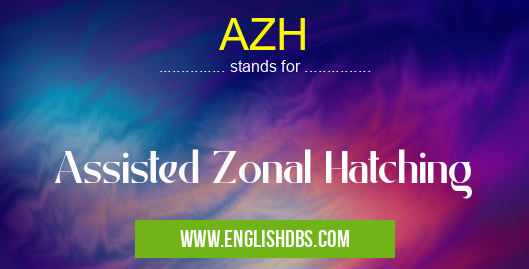What does AZH mean in UNCLASSIFIED
AZH: Assisted Zonal Hatching

AZH meaning in Unclassified in Miscellaneous
AZH mostly used in an acronym Unclassified in Category Miscellaneous that means Assisted Zonal Hatching
Shorthand: AZH,
Full Form: Assisted Zonal Hatching
For more information of "Assisted Zonal Hatching", see the section below.
Assisted Zonal Hatching (AZH) is a fertility treatment technique used during in vitro fertilization (IVF) to improve the chances of successful implantation.
AZH Meaning
AZH involves creating a small opening in the outer layer of an embryo's zona pellucida, a protective membrane that surrounds the embryo. This opening allows the embryo to hatch out of the zona pellucida, facilitating its attachment to the uterine lining.
AZH Procedure
AZH is typically performed using a laser or a chemical solution. A small hole is created in the zona pellucida, typically at a specific location. The embryo is then transferred to the uterus.
Benefits of AZH
- Improved implantation rates: AZH can increase the chances of embryo implantation by allowing it to hatch out and adhere to the uterine lining more easily.
- Increased pregnancy rates: By improving implantation rates, AZH can lead to higher pregnancy rates.
- Reduced miscarriage rates: Some studies suggest that AZH may reduce the risk of miscarriage.
Essential Questions and Answers on Assisted Zonal Hatching in "MISCELLANEOUS»UNFILED"
What is Assisted Zonal Hatching (AZH)?
Assisted Zonal Hatching (AZH) is a laboratory technique used in In Vitro Fertilization (IVF) to improve the chances of implantation and pregnancy. It involves creating a small opening in the zona pellucida, the hard outer layer surrounding the embryo. This opening allows the embryo to break free from the zona pellucida more easily, facilitating its attachment to the uterine lining.
Why is AZH used in IVF?
AZH is used in IVF to assist embryos that may have a thickened or hardened zona pellucida. This can occur in older women or those with certain hormonal imbalances. The thickened zona pellucida can make it difficult for the embryo to hatch and implant into the uterus. AZH helps to overcome this issue by creating an opening for the embryo to escape.
Is AZH safe and effective?
AZH is a well-established and safe technique used in IVF. Numerous studies have demonstrated its effectiveness in improving implantation rates and pregnancy outcomes. However, it is important to note that AZH does not guarantee pregnancy, and its success depends on various factors, including embryo quality and other aspects of the IVF process.
Who is a good candidate for AZH?
AZH is generally recommended for women with a history of failed IVF cycles, particularly those involving embryos with a thickened zona pellucida. It may also be considered for women with certain medical conditions, such as advanced maternal age or hormonal imbalances. The decision to use AZH should be made in consultation with a fertility specialist who will evaluate the individual patient's circumstances and determine the most appropriate course of treatment.
What are the potential risks of AZH?
AZH is generally a safe procedure, but like any medical intervention, it carries some risks. These include:
- Damage to the embryo: In rare cases, the laser or mechanical tool used to create the opening in the zona pellucida can inadvertently damage the embryo.
- Infection: It is possible for infection to occur at the site where the opening is created.
- Premature hatching: In some cases, the embryo may hatch prematurely after AZH, which can reduce its chances of successful implantation.
These risks are generally low, and the benefits of AZH often outweigh the potential drawbacks.
Final Words: AZH is a fertility treatment technique that can improve the chances of successful implantation and pregnancy during IVF. It is a safe and effective procedure that can be beneficial for certain patients undergoing IVF.
